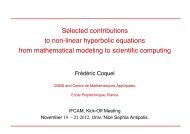The construction of the wonderful canon of logarithms
The construction of the wonderful canon of logarithms
The construction of the wonderful canon of logarithms
Create successful ePaper yourself
Turn your PDF publications into a flip-book with our unique Google optimized e-Paper software.
Notes. 93<br />
adapted to meet any requirements <strong>of</strong> accuracy. In sec. 60, Napier, in<br />
suggesting <strong>the</strong> <strong>construction</strong> <strong>of</strong> a table <strong>of</strong> <strong>logarithms</strong> to a greater number<br />
<strong>of</strong> places, proposes to take 1 00000000 as radius. <strong>The</strong> effect <strong>of</strong> this<br />
would be to throw still fur<strong>the</strong>r back <strong>the</strong> error involved in taking <strong>the</strong><br />
arithmetical mean <strong>of</strong> <strong>the</strong> limits for <strong>the</strong> true logarithm.<br />
Thus, using <strong>the</strong><br />
formula given, substituting 1 00000000 for n, and multiplying <strong>the</strong> result<br />
by that amount as already explained, we should have for <strong>the</strong> true<br />
logarithm <strong>of</strong> 99999999, <strong>the</strong> first proportional after radius in <strong>the</strong> new<br />
First<br />
table,<br />
1.000000005000000033333 etc.<br />
If we take <strong>the</strong> arithmetical mean <strong>of</strong> <strong>the</strong> limits, we have<br />
1.000000005000000050000 etc.<br />
This brings out a difference <strong>of</strong><br />
.000000000000000016666 etc.,<br />
or a sixty thousand billionth part <strong>of</strong> <strong>the</strong> logarithm. We see that <strong>the</strong><br />
<strong>logarithms</strong> only begin to differ in <strong>the</strong> i8th place, and that thus to however<br />
many places <strong>the</strong> radius is taken, <strong>the</strong> <strong>logarithms</strong> <strong>of</strong> proportionals<br />
deduced from it will be given with absolute accuracy to a very much<br />
greater number <strong>of</strong> places.<br />
To ensure accuracy in <strong>the</strong> figures given above, <strong>the</strong> three<br />
tables were recomputed strictly according to<br />
preparatory<br />
<strong>the</strong> methods described in<br />
<strong>the</strong> Constructio, fourth proportionals being found in all <strong>the</strong> preceding<br />
tables, and both limits <strong>of</strong> <strong>the</strong>ir <strong>logarithms</strong> being calculated, <strong>the</strong> work<br />
being carried to <strong>the</strong> 2 7th place after <strong>the</strong> decimal point.<br />
As <strong>logarithms</strong> to base e~' are now quite superseded, it is not worth<br />
while printing <strong>the</strong>se preparatory tables. <strong>The</strong> following values (pp. 94-95),<br />
however, may be <strong>of</strong> service for comparison, and as a check to any one<br />
who may desire to work out for himself <strong>the</strong> tables and examples in <strong>the</strong><br />
Constructio. <strong>The</strong> values given are <strong>the</strong> first proportional after radius, and<br />
<strong>the</strong> last proportional in each <strong>of</strong> <strong>the</strong> three tables, and also in <strong>the</strong> Third<br />
table, <strong>the</strong> last proportional in col. i, and <strong>the</strong> first proportionals in col.<br />
2 and 69. Opposite <strong>the</strong>se are given <strong>the</strong>ir <strong>logarithms</strong> to base e~^, computed,<br />
first, according to Napier's method, and second, by <strong>the</strong> present<br />
method <strong>of</strong> series which gives <strong>the</strong> value true to <strong>the</strong> last place, which is<br />
increased by unit when <strong>the</strong> next figure is 5 or more. <strong>The</strong> proportionals<br />
and <strong>logarithms</strong> are each multiplied by 1 0000000, as explained<br />
above.<br />
Though <strong>the</strong> <strong>logarithms</strong> in <strong>the</strong> Canon <strong>of</strong> 1614 were affected by <strong>the</strong><br />
-}<br />
M mistake


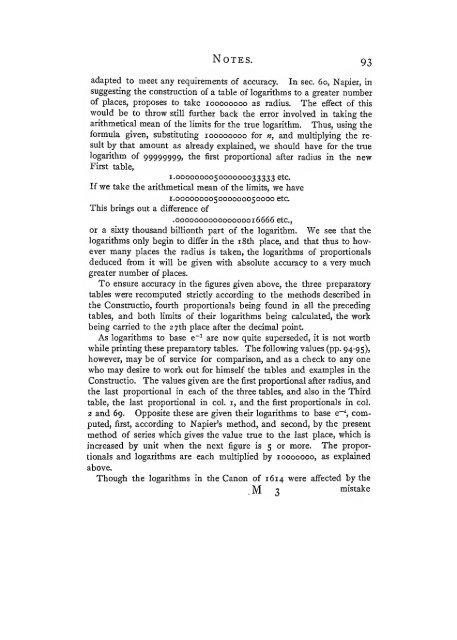
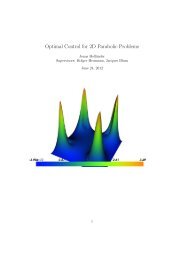
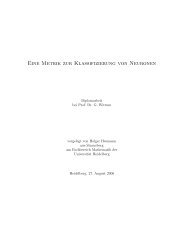
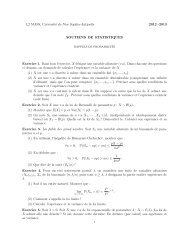
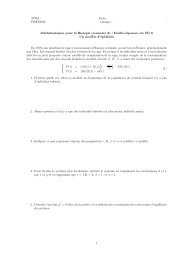


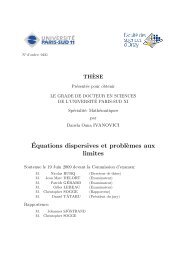
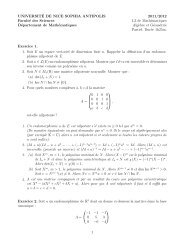
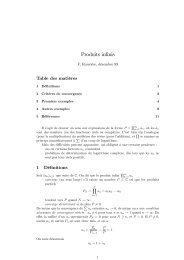
!['eries enti\`eres (+ [D78 Th d'Abel angulaire])](https://img.yumpu.com/14067031/1/184x260/eries-entieres-d78-th-dabel-angulaire.jpg?quality=85)
